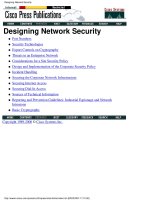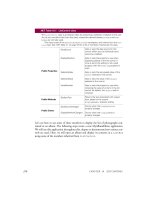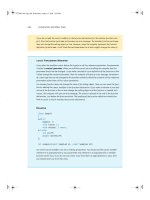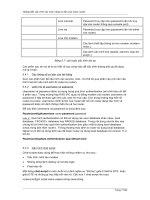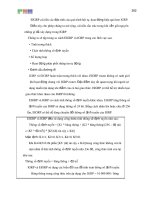designing network security cisco press phần 8 ppsx
Bạn đang xem bản rút gọn của tài liệu. Xem và tải ngay bản đầy đủ của tài liệu tại đây (57.96 KB, 40 trang )
! on serial lines using PPP. If the RADIUS server fails
! to respond, then local network authorization will be performed.
aaa authorization network dialup2 radius local
! username and password to be used for the PPP CHAP
username staff password letmein
radius-server host 144.254.9.6
radius-server key myRaDiUSpassWoRd
interface group-async 1
group-range 1 16
encapsulation ppp
! selects CHAP as the method of PPP authentication and applies
! the "dialup" method list to the specified interfaces.
ppp authentication chap dialup
! applies the dialup2 network authorization method list to the
! specified interfaces.
ppp authorization dialup2
line 1 16
! command used to allow a PPP session to start up automatically
autoselect ppp
! command used to display the username and password prompt without
! pressing the Enter key. After the user logs in, the autoselect
! function (in this case, PPP) begins.
autoselect during-login
Securing Dial-In Access
(22 of 103) [02/02/2001 17.33.17]
! command used to apply the staff method list for login authentication
login authentication staff
! command to configure modems attached to the selected lines to accept
! only incoming calls
modem dialin
Sample TACACS+ Database Syntax
Listing 10-3 shows the syntax used in CiscoSecure, the Cisco TACACS+ Access Control Server, for its
TACACS+ database. The syntax may change as more functionality is added;
this example is given to show what you can configure on the TACACS+ server side. Most TACACS+
servers employ similar functionality and often also have a simple-to-use graphical user interface that
creates the appropriate database for you.
Listing 10-3 The Syntax for the CiscoSecure Server
[unknown_user] = {
[user | group] = [<user name> | <group name>] {
password = [clear | chap | arap | pap | des] ["password"]
[from "dd mmm yy" until "dd mmm yy" | until "dd mmm yy"]
password = [skey | system | no_password] [from "dd mmm
yy" until "dd mmm yy" | until "dd mmm yy"]
password = file <"file name"> [from "dd mmm yy" until "dd
mmm yy" | until "dd mmm yy"]
privilege = [clear | des ] "<password>" [0-15]
privilege = [skey] [0-15]
Listing 10-3 Continued
default service = [permit | deny]
prohibit service = <service name>
Securing Dial-In Access
(23 of 103) [02/02/2001 17.33.17]
default attribute = [permit | deny]
allow <"nas name"> <"port name"> <"rem_addr">
refuse <"nas name"> <"port name"> <"rem_addr">
expires = [<"month day year"> | <"dd mmm yy">]
valid = [<"month day year"> | < "dd mmm yy">]
member = <group name>
service = shell {
default attribute = [permit | deny]
default cmd = [permit | deny]
prohibit cmd = <command>
set acl = <access-class number>
set autocmd = <"command">
set noescape = [ true | false]
set nohangup = [ true | false]
set priv-lvl = [ 0-15 ]
set timeout = <minutes>
set callback-dialstring = <phone number>
set callback-line = <line number>
set callback-rotary = <rotary number>
set nocallback-verify = 1
cmd = <command> {
[deny | permit] <"command arg">
default attribute = permit
Securing Dial-In Access
(24 of 103) [02/02/2001 17.33.17]
}
time = [<Mo, Tu, We, Th, Fr, Sa, Su 0000 - 2359> | <Any 0000 - 2359>]
}
service = ppp {
default protocol = [permit | deny]
prohibit protocol = <protocol>
protocol = lcp {
default attribute = [permit | deny]
set callback-dialstring = <phone number>
set callback-line = <line number>
set callback-rotary = <rotary number>
set nocallback-verify = 1
time = [<Mo, Tu, We, Th, Fr, Sa, Su 0000 - 2359> | <Any 0000 - 2359>]
}
protocol = vpdn {
set tunnel-id = <NAS name>
set ip-addresses = <"x.x.x.x x.x.x.x">
}
protocol = ip {
default attribute = [permit | deny]
set addr = <ip address>
set addr-pool = <ip local pool name>
set inacl = <input access-list number>
Securing Dial-In Access
(25 of 103) [02/02/2001 17.33.17]
set outacl = <output access-list number>
set route = <"destination_address mask gateway">
set routing = [ true | false ]
time = [<Mo, Tu, We, Th, Fr, Sa, Su 0000 - 2359> | <Any 0000 - 2359>]
}
protocol = ipx {
default attribute = [permit | deny]
set acl = <access-list number>
time = [<Mo, Tu, We, Th, Fr, Sa, Su 0000 - 2359> | <Any 0000 - 2359>]
}
protocol = atalk {
default attribute = [permit | deny]
set zonelist = <zonelist>
time = [<Mo, Tu, We, Th, Fr, Sa, Su 0000 - 2359> | <Any 0000 - 2359>]
}
}
The Lock-and-Key Feature
Lock-and-key is a traffic-filtering security feature in Cisco IOS devices that dynamically filters IP
protocol traffic. It can be used to authorize temporary access to specified areas of a corporate network.
Lock-and-key is configured using IP dynamic extended access lists and can be used in conjunction with
other standard access lists and static extended access lists.
When triggered, lock-and-key reconfigures the interface's existing IP access list to permit designated
users to reach specified areas of the network. When it is finished, lock-and-key reconfigures the interface
back to its original state.
For a user to gain access to a host through a router with lock-and-key configured, the user
must first Telnet to the router. When a user initiates a standard Telnet session to the router,
Securing Dial-In Access
(26 of 103) [02/02/2001 17.33.17]
lock-and-key automatically attempts to authenticate the user. If the user is authenticated, he or she then
gains temporary access through the router and can reach the destination host.
Currently, a user at a remote site can use WAN technology such as Asynchronous Transfer Mode
(ATM), dial-on-demand routing (DDR), Frame Relay, ISDN, PPP, or X.25 to connect to the corporate
office using lock-and-key.
The following steps describe the lock-and-key access operation (see Figure 10-4):
Step 1 A user opens a Telnet session to a border (firewall) router configured for
lock-and-key. The user connects using the virtual terminal port on the router.
Step 2 The Cisco IOS software receives the Telnet packet, opens a Telnet session, prompts for a
password, and performs a user authentication process. The user must pass authentication before access
through the router is allowed. The authentication process can be done by the router or by a central access
security server, such as a TACACS+ or RADIUS server.
Step 3 When the user passes authentication, he or she is logged out of the Telnet session, and the
software creates a temporary entry in the dynamic access list. (Per your configuration, this temporary
entry can limit the range of networks to which the user is given temporary access.)
Step 4 The user exchanges data through the router/firewall.
The software deletes the temporary access list entry when a configured timeout is reached or when the
system administrator manually clears the entry. The configured timeout can either be an idle timeout or
an absolute timeout.
Figure 10-4: A Lock-and-Key Operation
Note The temporary access list entry is not automatically deleted when the user terminates a session. The
temporary access list entry remains until a configured timeout is reached or until the entry is cleared by
the system administrator.
When lock-and-key is triggered, it creates a dynamic opening in the firewall by temporarily
reconfiguring an interface to allow user access. While this opening exists, another host can spoof the
authenticated user's address to gain access behind the firewall. Lock-and-key does not cause the address
spoofing problem; the problem is only identified here as a concern to the user. Spoofing is a problem
inherent to all access lists, and lock-and-key does not specifically address this problem.
To prevent spoofing, you can configure network data encryption as described in the last section of this
chapter. Configure encryption so that traffic from the remote host is encrypted at a secured remote router
Securing Dial-In Access
(27 of 103) [02/02/2001 17.33.17]
and is decrypted locally at the router interface that provides the lock-and-key service. You want to ensure
that all traffic using lock-and-key is encrypted when entering the router. In this way, no hackers can
spoof the source address because they are unable to duplicate the encryption or to be authenticated (a
required part of the encryption setup process).
Lock-and-Key Authentication
There are three possible ways to configure an authentication query process:
Configure a security server. Use a network access security server such as a TACACS+ server.
This method requires additional configuration steps on the TACACS+ server but allows for stricter
authentication queries and more sophisticated tracking capabilities.
●
Router# login tacacs
Configure the username command. This method is more effective than the preceding one because
authentication is determined on a user basis.
●
Router# username name password password
Configure the password and login commands. This method is less effective than the first method
because the password is configured for the port, not for the user. Therefore, any user who knows
the password can authenticate successfully.
●
Router# password password
Router# login local
Note It is recommended that you use the TACACS+ server for your authentication query process.
TACACS+ provides authentication, authorization, and accounting services. It also provides protocol
support, protocol specification, and a centralized security database.
Lock-and-Key Examples
The first lock-and-key example is shown in Figure 10-5. Here we show how to configure
lock-and-key access from a telecommuter to a NAS, with authentication occurring locally at the campus
NAS. Lock-and-key is configured on the BRI 0 interface of the NAS.
The configuration looks as follows:
! Telecommuter who will come in using lock-and-key
username telecommuter password 7 0758364708452A
isdn switch-type basic-dms100
!
interface ethernet 0
ip address 144.254.166.6 255.255.255.0
Securing Dial-In Access
(28 of 103) [02/02/2001 17.33.17]
interface BRI0
ip unnumbered ethernet 0
encapsulation ppp
dialer idle-timeout 3600
dialer wait-for-carrier-time 100
dialer map ip 171.73.34.33 name merike
dialer-group 1
isdn spid1 8316333715291
isdn spid2 8316339371566
ppp authentication chap
ip access-group 101 in
!
ip classless
ip route 0.0.0.0 0.0.0.0 144.254.166.6
ip route 144.254.166.6 255.255.255.255 BRI0
! allows Telnet from telecommuter to this router
access-list 101 permit tcp any host 144.254.166.6 eq telnet
! allows telecommuter to have access anywhere inside campus after Telneting
! to router and successful authentication
access-list 101 dynamic telecommuter timeout 120 permit ip any any
!
dialer-list 1 protocol ip permit
line vty 0
Securing Dial-In Access
(29 of 103) [02/02/2001 17.33.17]
login local
autocommand access-enable timeout 5
Figure 10-5: Lock-and-Key for Telecommuter Access
The first access-list entry allows only Telnet sessions into the router. The second access-list entry is
always ignored until lock-and-key is triggered.
After a user Telnets into the router, the router attempts to authenticate the user. If authentication is
successful, autocommand executes and the Telnet session terminates. The autocommand command
creates a temporary inbound access list entry at the Serial 0 interface, based on the second access-list
entry (telecommuter). This temporary entry expires after 5 minutes, as specified by the timeout value.
The second lock-and-key example is shown in Figure 10-6. This example shows how to configure
lock-and-key access for a branch router, with authentication on a TACACS+ server. Lock-and-key
access is configured on the BRI 0 interface of the NAS.
Figure 10-6: Lock-and-Key for Branch Router Access
The configuration on the NAS is as follows:
aaa new-model
aaa authentication login lockkey tacacs+ enable
aaa authorization exec tacacs+
!
isdn switch-type basic-dms100
Securing Dial-In Access
(30 of 103) [02/02/2001 17.33.17]
!
interface Ethernet0
ip address 144.254.166.6 255.255.255.0
!
interface BRI0
ip unnumbered Ethernet0
ip access-group 101 in
no ip mroute-cache
encapsulation ppp
dialer idle-timeout 300
dialer map ip 192.150.42.1 name Branchrouter 97328866
dialer-group 1
isdn spid1 8316333715291
isdn spid2 8316339371566
no fair-queue
compress stac
ppp multilink
!
router eigrp 100
network 144.254.0.0
!
ip classless
ip route 0.0.0.0 0.0.0.0 192.150.42.1
Securing Dial-In Access
(31 of 103) [02/02/2001 17.33.17]
ip route 192.150.42.1 255.255.255.255 BRI0
! allows Telnet from the branch hosts to this router
access-list 101 permit tcp any host 144.254.166.6 eq telnet
!
! allows anybody inside campus to have access to the branch resources
access-list 101 permit tcp any 144.254.0.0 0.0.255.255 established
!
! allows certain hosts inside to be accessed from the branch without authentication
access-list 101 permit ip any host 144.254.120.6
access-list 101 permit ip any host 144.254.120.8
!
! allows for branch to have access anywhere inside campus after Telneting
! to router and successful authentication
access-list 101 dynamic Branch timeout 5 permit ip any any
!
tacacs-server host 144.254.5.9
tacacs-server key secretkey
!
dialer-list 1 protocol ip permit
!
line con 0
exec-timeout 2 30
password letmein
Securing Dial-In Access
(32 of 103) [02/02/2001 17.33.17]
line vty 0 4
exec-timeout 15 0
! once user logs in, authentication is by way of tacacs+
login authentication lockkey
The configuration on TACACS+ is as follows:
user = lockkeyuser {
password = clear "secretword"
service = shell {
! following turns on the dynamic access-list
set autocmd = "access-enable"
}
}
The third lock-and-key example shows a configuration in which two users can have different
lock-and-key dynamic access list configurations and different access privileges. If these two users access
the device from the same interface, only the first configured dynamic ACL is activated.
interface Ethernet0/0
ip address 144.254.163.2 255.255.255.0
ip access-group 161 in
no ip directed-broadcast
no ip mroute-cache
!
interface Ethernet0/1
ip address 144.254.166.8 255.255.255.0
ip access-group 141 in
no ip directed-broadcast
Securing Dial-In Access
(33 of 103) [02/02/2001 17.33.17]
no ip mroute-cache
!
access-list 141 dynamic genesis permit ip any any log
access-list 141 permit ip any host 224.0.0.10
access-list 141 permit ip any any
access-list 161 dynamic new permit tcp any any log
access-list 161 permit ip any any
Double Authentication/Authorization
When a remote user dials in to a local corporate perimeter host (a NAS or router) over PPP, CHAP or
PAP can be used to authenticate the user. However, both of these authentication methods rely on a secret
password (the "secret") that must be stored on the local host and either remembered by a user or saved on
the remote host. If either host ever comes under the control of a network attacker, the secret password is
compromised.
Consider a corporate user who often uses a laptop computer to log in to the corporate enterprise network,
which uses only CHAP for authentication. If the laptop computer is ever stolen, the computer can still
connect to the corporate network if the correct dial-in script is executed.
With the double authentication feature, there are two authentication/authorization stages. These two
stages occur after a remote user dials in and a PPP session is initiated.
In the first stage, the user logs in using the remote host name. CHAP (or PAP) authenticates the remote
host and then PPP negotiates with RADIUS or TACACS+ to authorize the remote host. In this process,
the network access privileges associated with the remote host are assigned to the user.
Note You should restrict authorization at this first stage to allow only Telnet connections to the local
host. This arrangement prevents an attacker from using the device authentication to access the NAS and
to then Telnet from the NAS to other parts of the network.
In the second stage, the remote user must Telnet to the NAS to be authenticated. When the remote user
logs in, the user must be authenticated with the specified login authentication. The user then must enter
the access-profile command to be reauthorized. When this authorization is complete, the user has been
double authenticated and can access the network according to per-user network privileges.
WARNING Double authentication can cause certain undesirable events if multiple hosts share a PPP
connection to a NAS. If user Belvekdoir initiates a PPP session and activates double authentication at the
NAS, any other user automatically has the same network privileges as Belvekdoir until Belvekdoir's PPP
Securing Dial-In Access
(34 of 103) [02/02/2001 17.33.17]
session terminates. This happens because Belvekdoir's authorization profile is applied to the NAS's
interface during the PPP session; any PPP traffic from other users uses the PPP session that has already
been established.
Another undesirable event can occur if, in the middle of Belvekdoir's PPP session, another user, Jim,
executes the access-profile command. This action results in a reauthorization; Jim's authorization profile
is applied to the interface, replacing Belvekdoir's profile. This replacement can disrupt or halt
Belvekdoir's PPP traffic or grant Belvekdoir additional authorization privileges he or she should not
have.
This following example shows the configuration on a Cisco NAS. The first three lines configure a
TACACS+ server. The next two lines configure PPP and login authentication, and the last two lines
configure network and EXEC authorization. The last line is necessary only if the access-profile
command will be executed as an autocommand.
aaa new-model
tacacs-server host 144.254.5.9
tacacs-server key mytacacskey
aaa authentication ppp default tacacs+
aaa authentication login default tacacs+
aaa authorization network tacacs+
aaa authorization exec tacacs+
The sample configuration in Listing 10-4 shows authentication/authorization profiles on the TACACS+
server for the remote host psycho and for three users (usernames Merike-default, Wayne-merge, and
Tom-replace). The configurations for these three usernames show different configurations that
correspond to the three different forms of the access-profile command. The three user configurations also
show how to set up autocommand for each form of the
access-profile command.
Listing 10-4 Authentication/Authorization Profiles on the TACACS+ Server
key = "mytacacskey"
default authorization = permit
#
# This allows the remote host to be authenticated by the local host
# during fist-stage authentication, and provides the remote host
Securing Dial-In Access
(35 of 103) [02/02/2001 17.33.17]
# authorization profile.
#
user = psycho
{
login = cleartext "welcome"
chap = cleartext "welcome"
service = ppp protocol = lcp {
interface-config="ip unnumbered ethernet 0"
}
service = ppp protocol = ip {
# It is important to have the hash sign and some string after
# it. This indicates to the NAS that you have a per-user
# config.
inacl#3="permit tcp any 192.150.42.0 0.0.0.255 eq telnet"
inacl#4="deny icmp any any"
route#5="192.150.42.0 255.255.255.0"
route#6="192.150.41.0 255.255.255.0"
}
}
# - Without arguments access-profile removes any access-lists it can find
# in the old configuration (both per-user and per-interface), and makes sure
Securing Dial-In Access
(36 of 103) [02/02/2001 17.33.17]
# that the new profile contains ONLY access-list definitions.
#
user = Merike-default
{
login = cleartext "welcome"
chap = cleartext "welcome"
service = exec
{
# this is the autocommand that executes when Merike-default logs in
autocmd = "access-profile"
}
service = ppp protocol = ip {
# Put whatever access-lists, static routes, and so on here
# If you leave this blank, the user will have NO IP
# access-lists (not even the ones installed prior to
# this)
inacl#3="permit tcp any host 144.254.166.10 eq telnet"
inacl#4="deny icmp any any"
}
}
# With the 'merge' option, all old access-lists are removed (as before),
Securing Dial-In Access
(37 of 103) [02/02/2001 17.33.17]
# but then (almost) all AV pairs are uploaded and installed. This
# will allow for uploading any custom static routes, filters, and so on,
# that the user may need in his or her profile. This needs to be used with
# care, as it leaves open the possibility of conflicting configurations.
#
user = Wayne-merge
{
login = cleartext "welcome"
chap = cleartext "welcome"
service = exec
{
# this is the autocommand that executes when Wayne-merge logs in
autocmd = "access-profile merge"
}
service = ppp protocol = ip
{
# Put whatever access-lists, static routes, and so on here
Listing 10-4 Continued
# If you leave this blank, the user will have NO IP
# access-lists (not even the ones installed prior to
# this)
inacl#3="permit tcp any any"
route#2="144.254.0.0 255.255.0.0"
Securing Dial-In Access
(38 of 103) [02/02/2001 17.33.17]
}
}
#- With the 'replace' option,
# ALL old configuration is removed and ALL new configuration is installed.
#
# One caveat: access-profile checks the new configuration for address-pool and
# address AV pairs. As addresses cannot be renegotiated at this point, the
# command will fail (and complain) when it encounters such an AV pair.
# Such AV pairs are considered to be "invalid" for this context.
#
user = Tom-replace
{
login = cleartext "welcome"
chap = cleartext "welcome"
service = exec
{
# this is the autocommand that executes when Tom-replace logs in
autocmd = "access-profile replace"
}
service = ppp protocol = ip
{
# Put whatever access-lists, static routes, and so on here
Securing Dial-In Access
(39 of 103) [02/02/2001 17.33.17]
# If you leave this blank, the user will have NO IP
# access-lists (not even the ones installed prior to
# this)
inacl#3="permit tcp any any"
inacl#4="permit icmp any any"
route#2="171.71.73.0 255.255.255.0"
}
}
Automated Double Authentication
You can make the double-authentication process easier for users by implementing automated double
authentication. Automated double authentication provides all the security benefits of double
authentication, but offers a simpler, more user-friendly interface for remote users. With double
authentication, a second level of user authentication is achieved when the user Telnets to the NAS or
router and enters a username and password. With automated double authentication, the user does not
have to Telnet to the NAS; instead, the user responds to a dialog box that requests a username and
password or personal identification number (PIN).
Note To use the automated double-authentication feature, the remote user hosts must be running
a companion client application. As of Cisco IOS Release 12.0, the only client application software
available is the Glacier Bay application server software for PCs.
Listing 10-5 shows a complete configuration file for a Cisco IOS router with automated double
authentication.
Listing 10-5 Complete Configuration File for Automated Double Authentication
hostname myrouter
!
no service password-encryption
!
! The following command enables AAA:
aaa new-model
Securing Dial-In Access
(40 of 103) [02/02/2001 17.33.17]
! The following command enables user authentication via the TACACS+ server:
aaa authentication login default tacacs+
aaa authentication login console none
! The following command enables device authentication via the TACACS+ server:
aaa authentication ppp default tacacs+
! The following command causes the remote user's authorization profile
! to be downloaded from the TACACS+ server to the Cisco router when required:
aaa authorization exec tacacs+
! The following command causes the remote device's authorization profile
! to be downloaded from the TACACS+ server to the Cisco router when required:
aaa authorization network tacacs+
!
enable secret thisisasecret
!
ip host twiggy 192.150.42.101
ip host minky 192.150.42.103
ip host itchy 192.150.42.105
ip domain-name mycompany.com
ip name-server 144.254.5.27
! The following command globally enables automated double authentication:
ip trigger-authentication timeout 60 port 7500
isdn switch-type basic-5ess
!
Securing Dial-In Access
(41 of 103) [02/02/2001 17.33.17]
!
interface Ethernet0
ip address 144.254.166.10
no ip route-cache
no ip mroute-cache
no keepalive
ntp disable
no cdp enable
!
interface Virtual-Template1
ip unnumbered Ethernet0
no ip route-cache
no ip mroute-cache
Listing 10-5 Continued
!
! Automated double authentication occurs via the ISDN BRI interface BRI0:
interface BRI0
ip unnumbered Ethernet0
! The following command turns on automated double authentication at this
! interface:
ip trigger-authentication
! PPP encapsulation is required:
encapsulation ppp
Securing Dial-In Access
(42 of 103) [02/02/2001 17.33.17]
no ip route-cache
no ip mroute-cache
dialer idle-timeout 500
dialer map ip 192.150.42.1 name Brabch2 5554768
dialer-group 1
no cdp enable
! **The following command specifies that device authentication occurs via PPP
! CHAP:
ppp authentication chap
!
router eigrp 109
redistribute static
network 144.254.0.0
no auto-summary
!
ip default-gateway 172.18.1.1
no ip classless
ip route 192.150.42.0 255.255.255.0 Bri0
!
! Virtual profiles are required for double authentication to work:
virtual-profile virtual-template 1
dialer-list 1 protocol ip permit
no cdp run
!
Securing Dial-In Access
(43 of 103) [02/02/2001 17.33.17]
! The following command defines where the TACACS+ server is:
tacacs-server host 144.254.5.9 port 1049
tacacs-server timeout 90
! The following command defines the key to use with TACACS+ traffic (required):
tacacs-server key mytacacskey
!
line con 0
exec-timeout 10 0
login authentication console
line aux 0
transport input all
line vty 0 4
exec-timeout 10 0
password lab
!
Accounting and Billing
In large corporations, accounting and billing are essential for keeping track of who is accessing which
corporate resources. Although it is mostly a network management function, keeping a historical database
of dial-in usage patterns can alert the network administrator to any unusual activity and can serve as a
historical paper trail when an intrusion does occur. The important parameters to keep track of include the
following:
Origin of connection
●
Destination of connection●
Duration of connection●
Securing Dial-In Access
(44 of 103) [02/02/2001 17.33.17]
TACACS+ and RADIUS Accounting
When aaa accounting is enabled, the NAS reports user activity to the TACACS+ or RADIUS security
server (depending on which security method you have implemented) in the form of accounting records.
Each accounting record contains accounting attribute-value (AV) pairs and is stored on the security
server. This data can be analyzed for network management, client billing, and auditing purposes.
Like authentication and authorization method lists, method lists for accounting define the way accounting
is performed. Named accounting method lists enable you to designate a particular security protocol to be
used on specific lines or interfaces for accounting services.
aaa accounting <event type> {default | list-name}{start-stop | wait-start
|stop-only | none} [ method1 [method2]]
Five different event types are supported:
Event Description
system Enables accounting for all system-level events not associated with users (such as reloads).
network Enables accounting (including packet and byte counts) for all network-related requests,
including SLIP, PPP, and ARAP sessions.
connection Provides information about all outbound connections made from the NAS, such as Telnet,
local-area transport (LAT), TN3270, packet assembler/disassembler (PAD), and rlogin.
exec Enables accounting for EXEC processes (user shells).
command Applies to the EXEC mode commands a user issues. Command authorization attempts
authorization for all EXEC mode commands, including global configuration commands associated with a
specific privilege level.
You can specify when accounting records are to be sent by using one of the following keywords:
Keyword Description
start-stop An accounting start record is sent to the server as soon as the session begins (it does not wait
for an acknowledgment from the server). A stop record is sent when the session ends and includes the
session statistics.
wait-start An accounting start record is not sent until an acknowledgment is received from the server that
the session has started. A stop record is sent when the session ends and includes the session statistics.
stop-only The NAS sends only an accounting stop at the end of the session; the stop record includes the
session statistics.
none Stops all accounting activities on a line or interface.
Cisco IOS software supports the following two methods for accounting:
Method Description
Securing Dial-In Access
(45 of 103) [02/02/2001 17.33.17]
TACACS+ The NAS reports user activity to the TACACS+ security server in the form of accounting
records. Each accounting record contains accounting AV pairs and is stored on the security server.
RADIUS The NAS reports user activity to the RADIUS security server in the form of accounting
records. Each accounting record contains accounting AV pairs and is stored on the security server.
In the following sample configuration, RADIUS-style accounting is used to track all usage of EXEC
commands and network services such as SLIP, PPP, and ARAP:
aaa accounting exec start-stop radius
aaa accounting network start-stop radius
Accounting records are text lines containing tab-separated fields. The first six fields are always the same:
Timestamp
●
NAS name●
Username●
Port●
Address●
Record type●
Centralized Billing
For central control of dial-in use and a centralized billing strategy, it is often the requirement of large
corporations to use a callback mechanism (see Figure 10-7).
Figure 10-7: A Callback Example
The steps for a callback are as follows:
Step 1 Remote user dials in to network access server.
Step 2 The NAS disconnects the call.
Step 3 The NAS authenticates the remote user.
Step 4 If the user is authenticated, the NAS initiates a call to the remote user and a connection is
established.
Configurations for both the NAS and the TACACS+ servers are shown in Listings 10-6 and 10-7.
Securing Dial-In Access
(46 of 103) [02/02/2001 17.33.17]
